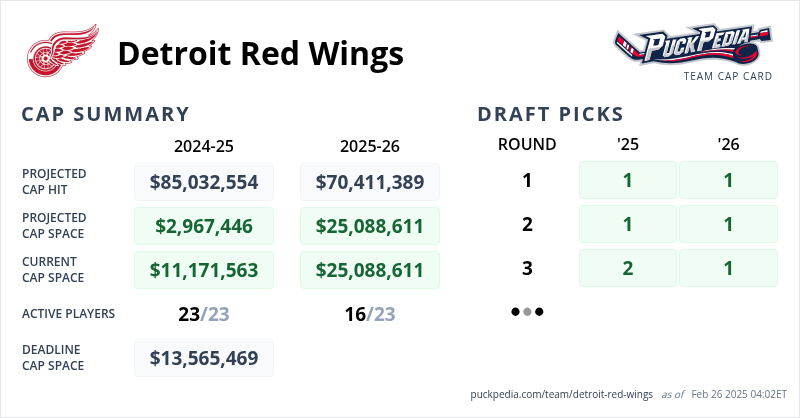NHL News
How Andrew Copp’s Injury Affects the Red Wings’ Cap Space

Image © Rick Osentoski-Imagn Images
The Detroit Red Wings announced that Andrew Copp underwent surgery to repair a pectoral tendon, ruling him out for the remainder of the 2024-25 season. With a $5.625 million cap hit, some have speculated that placing him on long-term injured reserve (LTIR) will give Detroit additional flexibility at the trade deadline.
However, LTIR works differently than some believe. While it allows teams to exceed the salary cap under certain conditions, it does not function as extra cap space for a team operating below the cap and accruing space. Understanding how LTIR works is key to knowing why it is unlikely to significantly change the moves Detroit may make leading up to the deadline.
How LTIR Affects a Team’s Cap Space
LTIR Doesn’t Remove a Player’s Cap Hit
When a player is placed on LTIR, their salary cap hit is not deducted from a team’s cap space. LTIR allows a team to exceed the salary cap by a set amount, known as the LTIR pool. The size of that pool depends on a team’s cap situation at the time of the LTIR placement.
- If a team is under the cap before placing a player on LTIR, their LTIR pool is calculated as: Player's Cap Hit - Team's Cap Space at the time
- If a team starts the season over the cap and needs LTIR to be compliant, the LTIR pool equals the amount they exceeded the cap when placing the player on LTIR.
Because of this, teams often make last-minute roster adjustments before using LTIR at the start of the season to maximize their available LTIR pool.
LTIR and Cap Space Accrual
Another key factor is that LTIR teams do not accrue cap space the way teams under the cap do. When a team operates below the cap, any unused space builds up daily, giving them more flexibility as the season progresses. Teams in LTIR, however, do not benefit from this effect, meaning any unused portion of their LTIR relief cannot be saved for later.
Understanding Detroit’s Cap Space at the Deadline
The Red Wings are not an LTIR team—they have been operating under the salary cap all season. That means they accrue cap space daily and will have a substantial amount by the deadline. Here’s how it works:
- Projected Cap Space: The amount of cap space the team will finish the season with if they do not make any other roster moves. As of Feb 25, Detroit has $3 million of Projected Cap Space
- Current Cap Space: The amount of annual cap hit that can be added today, based on the percentage of the season remaining. As of Feb 25, 26% of the season remains, so a player with an $11.2 million cap hit would only require $3 million in projected cap space to fit on the roster.
- Deadline Cap Space: The amount of annual cap hit that can be added at the trade deadline. On deadline day, 22% of the season will remain, meaning that a $13.6M cap hit only requires $3 million projected cap space to fit on the roster.
Because Detroit has been under the cap all year, they are projected to have $13,565,469 in cap space at the deadline, which is a substantial amount.
For Copp’s LTIR designation to matter, Detroit would need to add between $11–13 million in salary at the deadline just to reach a point where LTIR space would come into play. The exact amount depends on other roster moves that the team may make in the coming days. Given how much cap room they already have, it’s therefore unlikely for the Copp LTIR to make an impact.
Final Thoughts
While LTIR is an important tool for cap-strapped teams, it doesn’t provide additional space for teams already operating under the cap like the Red Wings. Detroit is already in a strong position to make moves without needing LTIR relief.
For a deeper dive into how the salary cap and LTIR work, visit PuckPedia’s Capology page and PuckPedia’s LTIR page.









